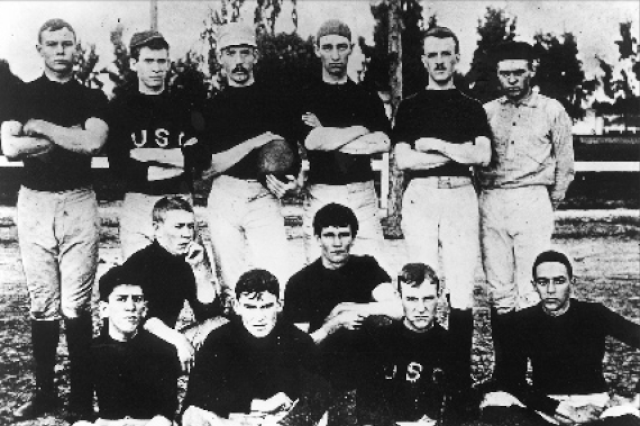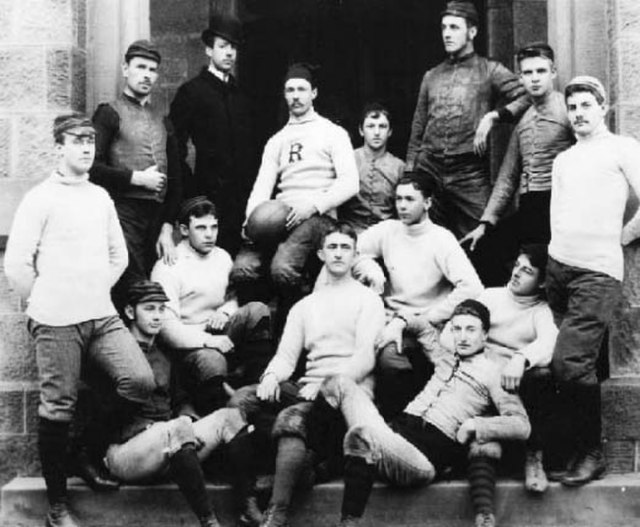In this edition of the Football's History Rewind, we discuss the fantastic rule revisions of allowing low tackles and prohibiting chain fence defense. It is provided to create the second and third layers of defense. So, the umpire position for officials, linebackers, and defensive backs for the defense started.
Football 1887 and 1888
Football 1887 and 1888
The Umpire Strikes Back
Pigskin Dispatch's Part 10 in the Series on American Football History
Part 9 of our ongoing series on the history of early football rules left off with changes incorporated at the rules convention of March 26, 1887. The group of rules makers did not wait long to meet again as another convention was held on May 14 of the same year.
.jpg)
1887 Notre Dame football team, University of Notre Dame archives via Wikimedia Commons, taken by unknown photographer
Notre Dame officially fielded the school's very first football team in the season of 1887. The first game was on November 23, 1887 in a 0-8 loss to the University of Michigan. The Irish finished the season with an 0-3 record, as they also dropped games to Michigan in April of 1888.
The second and third conventions of 1887
This gathering was attended by the same men that attended the earlier March convention and was intended to finish up some unsettled business that could not be accomplished in March.
After much thought in the months between the two spring conventions of 1887 the group decided on adopting provisions to have a second referee on the field at the games. The idea was to have one ref watching the players and a second who would be responsible for and have jurisdiction over the ball.
There was much to work out on the addition of this second referee to games and thus a third convention of 1887 was held in June. At this congregation more detail was added to the double referee system that would be implemented. First was for the assigning of the championship game referees. The group decided that the captains of the two championship teams should select the referee with jurisdiction of the ball. The referee who presided over the players would be selected by the advisory committee. It was also decided that to avoid confusion the ref designated to have jurisdiction over players would now be called the umpire.
.jpg)
1887 Yale University football team courtesy Wikimedia Commons, taken by unknown photographer
It is interesting to see how today the traditions of the umpire being responsible for players and the referee with the ball are still carried on to this day in some respects. The ref is in the backfield where the ball generally goes first when it first becomes live and the umpire is in position to watch the players on the line as a primary responsibility. Many associations still have the umpire responsible for checking player equipment before the game and the referee approving game balls prior to the opening kick. The old saying “the more things change the more they stay the same,” rings somewhat true in these instances.
The Champions of the 1887 season were the Yale Bulldogs pictured above. The team finished with a 9–0 record and was retroactively named as the national champion by the Billingsley Report, Helms Athletic Foundation, Houlgate System, National Championship Foundation, and historian Parke H. Davis. The game of the season was the Harvard vs. Yale matchup held at the Polo Grounds in New York City. The Crimson entered the game undefeated at 10-0 as they had outscored their opponents 652-6. Yale was also unblemished at 8-0 and sported 500 points for and only 4 against them up till that game. Yale triumphed 17-8 over Harvard to take the title.

1887 University of Michigan football team taken by unknown photographer, courtesy Wikimedia Commons
Big changes occur in early ‘88
There was a dramatic turn in the balance of power between offenses and defenses the following spring that helped shape the game. There were only four rules amendments at this convention but two of them had a tremendous impact on how the game was played. Defensive advantages over their opponents took a tremendous hit at the convention of March 3, 1888 but were returned by giving the defense a tremendous weapon.
Rule 14 was altered to prohibit players on the rush-line (defensive line) from blocking with extended arms. What this did was make it illegal for the defensive line to perform a common practice of that day in clasping hands with the nearest teammate to form a human chain link fence across the field of play that would hinder progress of the offense.

The 1888 USC team tqken by an unknown photographer, courtesy Wikimedia Commons
The second “biggie” in the rules amendments from this convention was to alter rule 26 on tackling. The new rule revision would now permit defensive players to tackle a runner low between the waist and the knee. Prior to this the rules only permitted tackling above the waist. This was a huge in changing the game because often times the strategy of the offense was to have their runners “bob and weave” out of the high tackles of defenders when they rushed the ball.
The offense was now forced to bring the once wide open formations into tighter quarters. Prior to these rule changes the offense lines would stand no closer than just out of arms reach to their closest team mate. The backs would be many yards behind their linemen and often were spread outside the ends on their lines. The low tackle adversely changed the offense formations to now have the linemen shoulder to shoulder and the backs were now within four yards of their offense line players. The wide open plays of prior seasons now would turn into quick plunges and masses of humanity piled up against each other.

The 1888 Penn State Football team taken by an unknown photographer, courtesy Wikimedia Commons
Innovative coaching tactics sprung up with the rule changes that not only confused the opposition but also the officials. Princeton devised a play they originally called the “split-the-line-open” play or later known as “boxing the tackle.” It was a blocking scheme by the O line that had not been seen before, where offensive players would purposely try to push via a block, their opponent into a direct that would be favorable for a runner to have a hole to run through. This is a common item now but at the time was very out of the ordinary. It was effective too as the first time Princeton used the play against rival Yale, the runner produced about a forty yard gain on the play to the five yard line! The strangeness of the play provided uncertainty to the officials to the point of bringing the play back to midfield fearing that some rule must have been broken on the play.
Yale had their own innovation to combat the now lower tackling defenders. They sent a blocking back through the line before the runner to nullify any awaiting defenders that may pose a threat to the advance of the ball carrier. This was much different than that of the rules of rugby which at the time prevented players from blocking in advance of the ball.
The defenses soon countered these new offensive innovations by developing one of their own. They placed defenders behind the tackles forming what is now the linebackers and defensive secondary.
These seemingly subtle rule changes transformed the game away from the rugby style it had been to that point, and laid a great foundation for things to come. Please find the continuation of this story in the next edition of the Dispatch’s football history lesson coming soon, right here on PigskinDispatch.com, your place for the good news about football.
We are able to give this in depth look from so long ago in history by careful research. Using someone who was contemporary to the period is the best source. So a very special shout out to our main source of reference information for this article is from Parke H. Davis in his 1911 book Football-The American Intercollegiate Game.

The 1888 Rutgers team photo taken by an unknown, courtesy Wikimedia Commons






